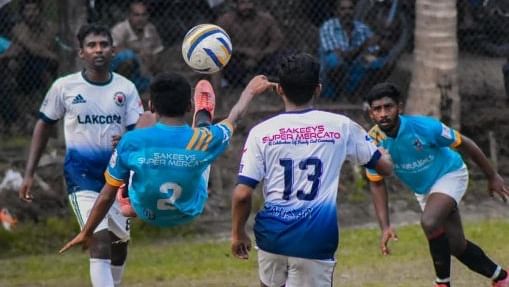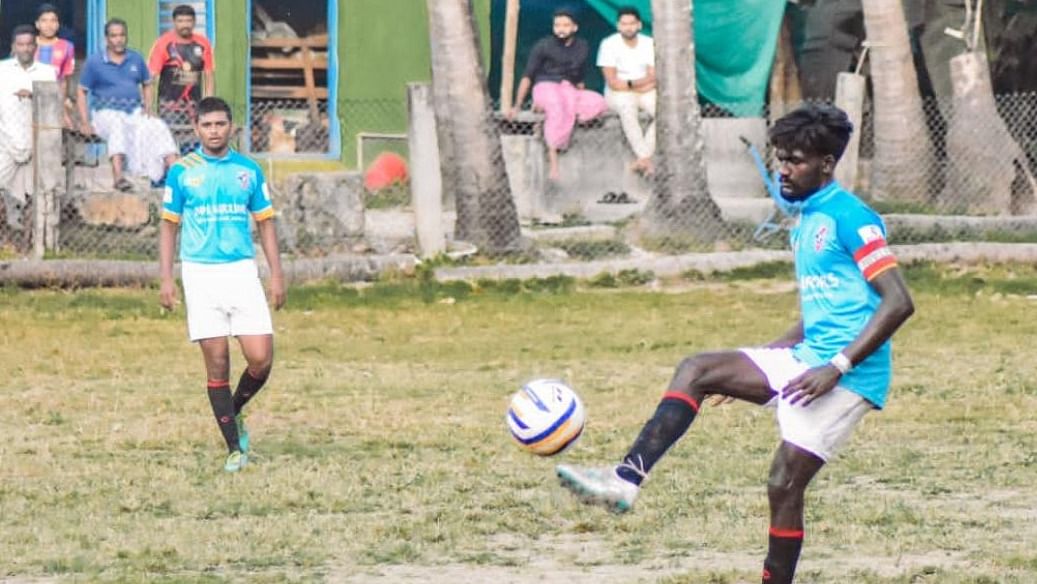

If the kids of Lakshadweep Football Academy were in awe of the Padukone-Dravid Centre of Excellence and the facilities on offer during the AIFF’s Elite Youth League, they could be forgiven for it. For such luxury is not in their purview.
Travelling via ship and train and reaching Bengaluru the day before their first match, the two wins and two losses were not enough to qualify for the next round, but the fact that they beat Parappur FC, whose U-13, U-15 and U-18 teams were district champions, 3-0 and Maharashtra’s Kenkre FC, whose first team plays in the I-league, 2-0 is victory enough for them.
Baby steps, in the right direction.
“It was turf ground so it was really difficult for us to play,” admits Thasim, LFA’s team manager. “We play in mud or normal ground with patches of grass. We are not used to such facilities… the players had ankle, knee and back pains, the ball moved quicker… ”
“This is the first time these kids have played in such a good tournament. These kids played in the Subroto Cup in Delhi before, some played and won the Neelagiri U-17 tournament last year. This is just the start…”
So it is. Lakshadweep, an archipelago made of 36 islands across 32 square km in the Arabian Sea, had no affiliation with the All India Football Federation till 2016. Their football, like the islands themselves, was left insulated, allowed to develop in relative isolation.
When India played the 71st Santosh Trophy in 2017, Lakshadweep played its first.
“When I went there they didn’t play too much 11-a-side football, they were not very familiar with it. They played 7s and 9s largely because Kavaratti (the capital) had only one proper ground. The others were smaller ones,” says Deepak CM, a coach from Calicut who went as part of a Premier League and British Council coach-education programme in 2018.
“There was only one qualified coach there (when I went) and the one I was part of was the first-ever coach education programme there,” he adds.
Full-size grounds are few and far, with not even all the 10 inhabited islands having one. And where there are grounds, it has a school adjacent and acts as a community ground.
“The same ground is used for school functions, Republic Day, Physical education hour and all games. Evenings the people from the neighbourhood also use it,” says Thasim.
A lot of the football is played on the beach, coconut groves and smaller grounds.
“The ground is not gravel... different from ours…,” says Ashik Usman, former Gokulam Kerala FC player and a known face in the Kerala 7s scene. He played in the Kavaratti league for two seasons.
“You slip a lot, it’s a very thin sort of gravel or sand…”
Football has been the islands’ love since the 1960s but without coaches to parrot the changes of modern football, in some ways, football in Lakshadweep retains echoes of a bygone era.
“When I played in the mainland, 4-4-2 or 4-3-3 formations were common, but we don’t see that in Lakshadweep. We play 3-3-4. I have never seen this anywhere else,” says Abdul Hashim, who played for Gokulam.
It’s not uncommon for sport to take on board the quirks of its society, especially when it is an integral part of everyday life. Without malls or theatres, it is a source of entertainment for the islanders. It is also a vehicle to keep youngsters away from social evils.
“Because they play a lot on the beach and in coconut groves, there is that strength and power. Our physio had to work hard because their muscles were all very tight from playing in the sand,” Deepak, who was the coach from 2018-20, adds.
School tournaments are huge in the Union Territory, with its lineage - under different guises and names, going back to the 70s.
The geography only adds to the complication and uniqueness of the island tournaments, with the commute between islands taking anywhere from an hour-and-a-half to hours to eight hours via high-speed craft.
“There are tournaments in different islands, hosted by clubs or people or even the government,” says a Lakshadweep Football Association official.
“People from other islands or Kerala (sometimes) have to stay there because they can’t finish the game and go back home. There are few sponsors because there is no visibility. So we get money from shop owners, contractors and others in the society to conduct tournaments here.”
The community aspect extends beyond the financial help.
“Sometimes the players stay in different people’s houses. There is also a culture, if you go to one island you stay in a certain house and use their vehicle… you go to another island then you do the same in another house and stuff like that,” says Deepak.
Tournaments are held for 10-15 days at a venue, the Kavaratti league being the longest going for a month.
“I stayed there for a month. People were coming for every game,” says Usman.
The games are played early mornings and evenings post-school hours. Sometimes teams play two games a day even. The schedule, tight as it is, made all the more so because the window for the action is restricted.
“From mid-September to April-May, we can do things. After that, monsoon affects island-to-Island connectivity badly. Very few ships. During monsoon, the high-speed crafts dock in cochin. Connectivity to the mainland is also bad, so going for tournaments outside is difficult because we have to get players from different islands to come. That is very difficult, especially for those from far-flung islands.”
The Lakshadweep FA is trying to make it work despite its limitations and challenges. The young team’s performance in Bengaluru and their Santosh Trophy matches have shown that there is talent.
In their first-ever 11-a-side outing under the banner of Lakshadweep, they stunned Telangana 1-0 in the qualification group games. A year later in 2018, they beat Madhya Pradesh and Daman and Diu by five goals. They also have two players in the Kerala Blasters ranks. All small victories.
“The Santosh Trophy performances have made a big impact. We didn’t qualify because bigger teams like Goa, Maharashtra, etc will come in the group and only one will qualify,” says Deepak.
Subsequent performances have been hot and cold from a team whose talent pool has to come from a population of less than 65,000.
“We are at an infant stage,” admits an LFA official, “There is one government-run academy (Lakshadweep Football Academy) linked to sports and youth affairs. We are doing coach licensing and referee training because we don’t have people here to coach. We are creating coaches and a structure here. There are no registered players in tournaments on different islands. Now we have started the process of registering players. We are legalising tournaments that happen on different islands. Then players can go out and play and players from outside can play here as well.”
Like their geography, football in Lakshadweep also long remained an island to itself. But no more. There is talent, interest and a will to improve and work.
Yes, they might be 71 years behind the rest of the country, but not too many nautical miles behind.